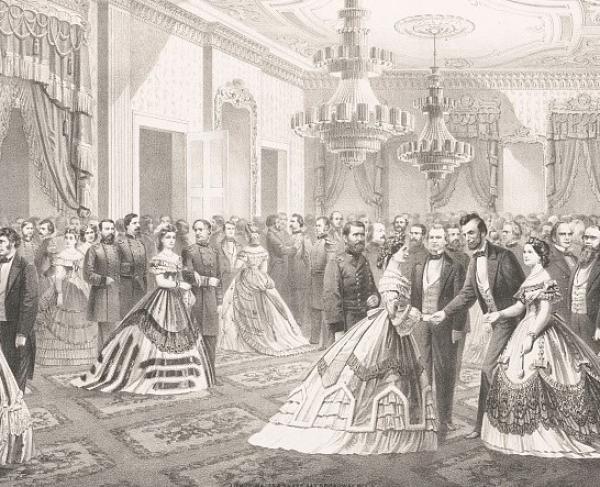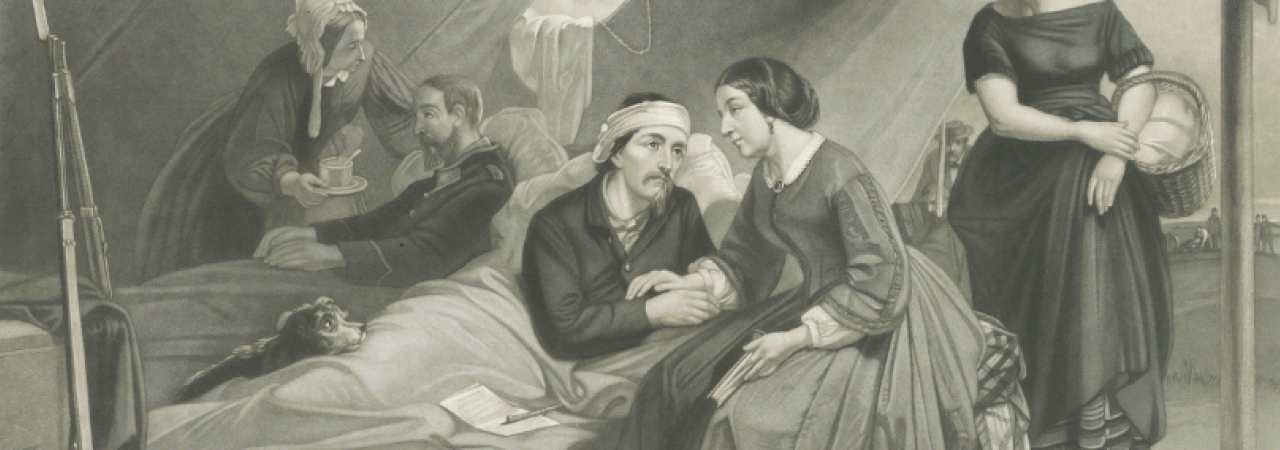
On September 6, 1862, Harper’s Weekly published a drawing titled “The Influence of Women”. In the engraving, women fulfill many important roles for the war effort, from sewing shirts and knitting socks as part of the sanitary commission, to washing clothing for soldiers as camp aides, as well as acting as “sisters of charity” ministering to soldiers in the field hospitals and helping wounded soldiers write letters back home. Many of these women depict efforts to heal and care for soldiers. The Harper’s Weekly picture shows the culmination of women’s efforts to take a more active and public role in the medical field serving as nurses treating wounded soldiers during the Civil War.
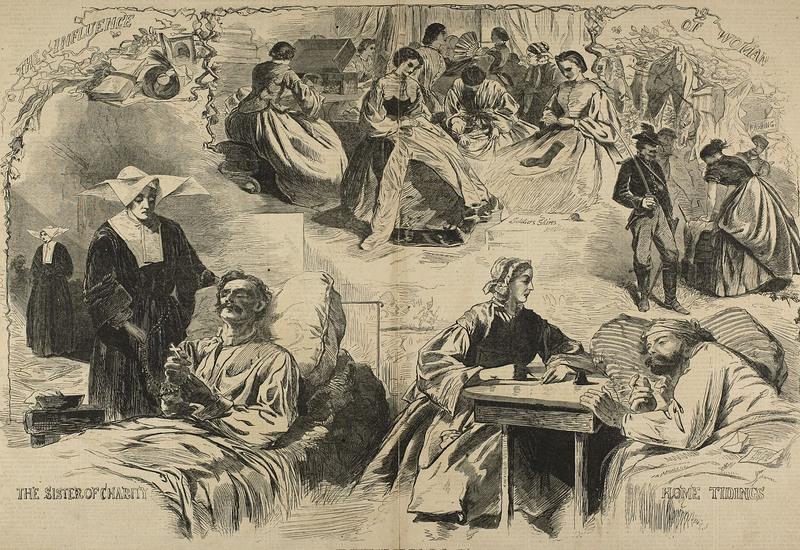
Prior to the Civil War, there were very few female nurses who publicly practiced medicine. Privately women often took care of sick family members within the home, but most doctors were men and did not routinely use the help of nurses. One of the few aspects of public medicine that few women practiced in the 19th century was midwifery in which they helped other women bear a child. When the Civil War began, both the Confederate and Union medical departments preferred having men rather than female nurses work in hospitals. Medical officers did not think that women had the constitution and hardiness for the hard work and were willing to follow military etiquette. Logistically, officers not want to expend the effort to provide the separate accommodations that were thought necessary for women to stay at the hospitals. However, this changed during the first few months of the war as medical departments on both sides were unprepared for the number of wounded soldiers that needed treatment in the hospitals. For example, throughout April and May 1861 too few medical stewards (male nurses) were assigned to hospitals. As a result, soldiers recovering from a disease or minor injuries were often ordered to assist their fellow patients. One soldier recovering in a hospital who experience this system remarked:
In the hospital, men lie on rotten straw...the nurses are convalescent soldiers, so nearly sick themselves that they ought to be in the wards, and from their very feebleness they are selfish and sometimes inhuman in their treatment of patients. If we could be sure of being half-way well cared for when we get sick or wounded, it would take away immensely from the horrors of army life.
Having sick and wounded soldiers caring for others did not work well and as early as June 1861 private aid groups such as Sanitary Commissions and Relief Societies, as well as the military, started to recruit female nurses to work in the hospitals. One of the most famous women who helped recruit nurses over the course of the Civil War was Dorothea Dix, who was appointed as the Superintendent of Nurses for the Union Army in June 1861. Dorothea Dix helped set the standard of qualifications for women in the nursing corps.
In order for a woman to become a nurse, she had to be between the age of 35-50, be in good health, be of decent character or “plain looking”, be able to commit to at least three months of service, and be able to follow regulations and the directions of supervisors. Dix even went so far as to say that women had to wear unhooped black or brown dresses, with no jewelry or cosmetics.
Women were able to join the war effort as nurses in a variety of ways. They could apply to join the nursing corps through the approval of sanitary commissions or superintendents such as Dorothea Dix, or they could be contract nurses hired on location based on need. In addition to white women, African American women worked in hospitals. Freed women were sometimes hired as contract nurses to both Confederate and Union hospitals, while some enslaved women were hired out to Confederate hospitals by their enslavers. If a woman was assigned to work in a hospital, she completed a wide variety of tasks to care for and treat the wounded.
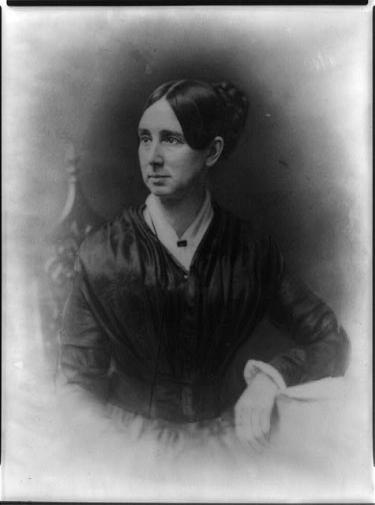
Similar to their pre-war experiences at home, women stepped into the domestic and caring aspects of the hospitals treating wounded soldiers. Not only did they provide medical care changing bandages and administering medicine, they also fed, clothed, and washed patients. In addition to providing physical care, they also offered mental care, comforting soldiers by writing letters, praying with them, and reading to them. Nurses also worked behind the scenes assisting with the management of supplies and operating the hospital kitchens and laundries. However, roles assigned to women often varied by race and class. Throughout the South, enslaved and free Black women were assigned more tedious positions such as cooks, laundresses, and chambermaids (cleaning bedpans and other messes). In many Union hospitals, the only patients they treated were African American soldiers, contrabands, and the other nurses while they were ill. Similar discrimination was seen in other Northern hospitals with lower-class and immigrant women being assigned the more menial roles in the hospitals.
The tasks for a nurse were both physically and mentally challenging. Most women never experienced a military hospital before and faced a steep learning curve once they encountered wounded soldiers. For some women, their first experiences were emotionally draining. Cornelia McDonald struggled on her first day working in a Winchester hospital after she stumbled over a pile of amputated limbs and was asked to clean a soldier’s face wound. Another Virginian nurse, Sarah Pryor, even passed out on her first day. Amy Morris Bradley, who was aiding the wounded at Fair Oaks was told by a surgeon to stop crying. It was only then she realized “that tears must be choked back…ACTION was the watchword of the hour!”. Not only where the sights of a hospital a struggle for nurses to overcome, the work was physically demanding as well.
Typically, nurses in hospitals were divided into shifts. At the Academy Hospital in Chattanooga, Tennessee nurses were divided into two shifts of twelve hours with “the first watch from 6 to 12, the 2d from 12 to 6 o’clk”. During each one of these shifts, the floors were to be “scrubbed or dry-rubbed, and swept, bedding changed or arranged, and everything put in order between the hours of 5 ½ and 6 ½ o’clock in the morning, both watches assisting in this labor”. During their shifts, nurses would make rounds to check in on their patients, feeding them, changing bandages, and administering medicines. It was during this time that some nurses could stop to talk with patients, write their letters, and provide comfort. Amanda Akin Stearns who worked at the Armory Hospital in Washington D.C, regularly worked an eighteen-hour day. She was “up at six, dispensed medicines, served breakfast, dispensed medicines, served dinner, wrote letters, dispensed medicine, served supper, and wrote letters”. Sometimes nurses even made the rounds with the surgeons, assisting with medical procedures if needed. In an Indiana hospital, Elvira Powers was asked to help a surgeon probe a soldier’s gangrenous arm. She later wrote in her diary, “It will be necessary to imbibe a little more of the heroic before I can be of much help during an operation” for she nearly fainted.
The number of patients and the types of wounds nurses cared for varied on the location of the hospitals. In the general hospitals further away from the battle lines, nurses cared for soldiers who had already been treated in field hospitals, who after being stabilized had been sent to the general hospitals to recover. Nurses in the hospitals closer to the front lines experienced more battle wounds and critically ill soldiers than the general hospitals. Throughout the city of Richmond, Phoebe Yates Pember cared for as many as 600 patients at Chimborazo Hospital while across the city a group of nuns cared for 500 at a time. In the Union hospitals in Washington D.C. and Alexandria, the number of occupied beds varied from just over 100 in some hospitals to over 2,000. Nurses also had to prepare beds for future battles. Prior to the Battle of the Wilderness, Emily Mason was directed to prepare 800 beds in a hospital outside of Fredericksburg for the incoming wounded. Another nurse in Fredericksburg in 1862 reported that “in one day she had singlehandedly cooked and served 926 rations of soup, farina (a cooked cereal), tea, and coffee”.
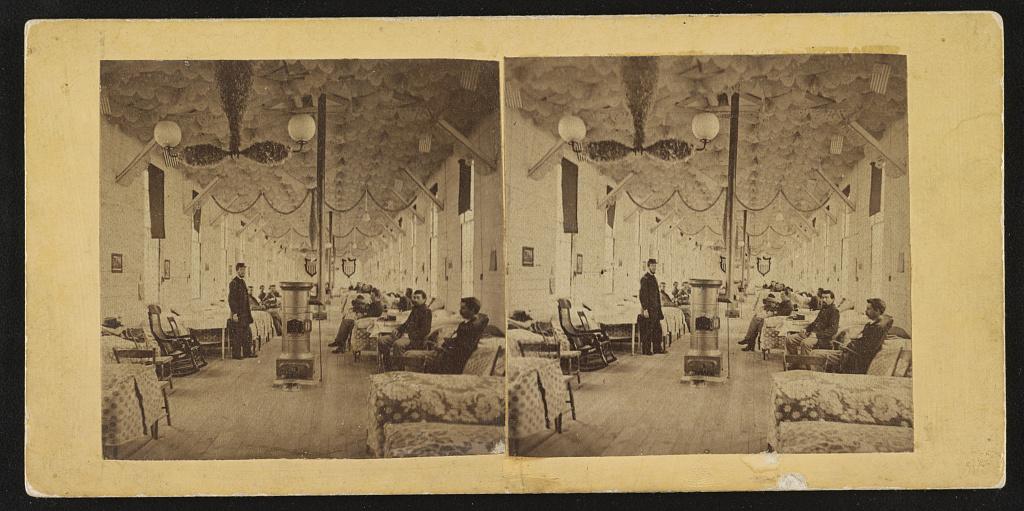
Serving as nurses in the hospitals was not without danger. Being exposed to wounded soldiers (some with infections) or illness made women vulnerable to getting sick themselves. Additionally, the germ theory was not fully discovered yet and so surgeons and nurses were not wearing gloves, washing hands regularly, nor sanitizing equipment as often as needed. As a result, getting sick in a hospital was a common danger. Louisa May Alcott, author of Hospital Sketches and Little Women served as a nurse at the Union Hospital in Washington D.C. beginning in December 1862. By January 1863 she was sick with typhoid pneumonia and was so ill she went home, ending her short career as a Civil War nurse. Many nurses over the course of the Civil War contracted a variety of diseases. While many survived, some died. Amanda Kimble served in a hospital south of Philadelphia and worked for only thirty-five days treating patients returning from the prison camp at Andersonville when she succumbed to typhoid. Several hospitals also had wards for soldiers infected with smallpox. Because of the severity of the disease, many of the women assigned to these wards were often either African Americans or immigrants. In Knoxville’s Asylum General Hospital, Malinda McFarland Jackson contracted smallpox and soon died. She was only fifteen years old.
At the start of the Civil War, some women argued that the war “was as much a woman’s war as it was a man’s war”. Over 21,000 women served in Union military hospitals and a similar number is estimated for the Confederacy, with 10% of those women being African American. However, because many Southerners nursed soldiers in local homes or churches, their service was never entered into the military service and so an exact number is unknown. Serving in the hospitals was one of the few ways that women could participate in the war and one of the ways they felt the most useful. One nurse, Ella Wolcott wrote:
I have been a ‘female nurse’ since a year ago last October and only regret that I did not go in the beginning when a mistaken humility is all that withheld me…I went in with many misgivings—but now I KNOW that women are worth in the hospitals. It is no light thing to hear a man say he owes you his life and then to know that mother, wife, sister, or child bless you in their prayers.
The Civil War allowed women to take a more active role outside of the home, serving as nurses in the hospitals, taking leading roles in sanitary commissions, as well as taking work in clerical roles in the government. Once women started working in public, it ultimately proved difficult for all women to return back to the domestic sphere after the war, paving the way for future generations to join the workforce, receive an education, vote, and take a more active role in society that many take for granted today.
Further Reading
- Hospital Sketches By: Louisa May Alcott
- Kate: The Journal of a Confederate Nurse By: Kate Cummings and edited by Richard Barksdale Harwell
- Mothers of Invention: Women of the Slaveholding South in the American Civil War By: Drew Gilpin Faust
- Women in the Civil War By: Mary Elizabeth Massey
- Women at the Front: Hospital Workers in Civil War America By: Jane E. Schultz

